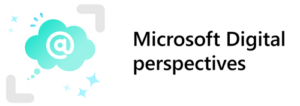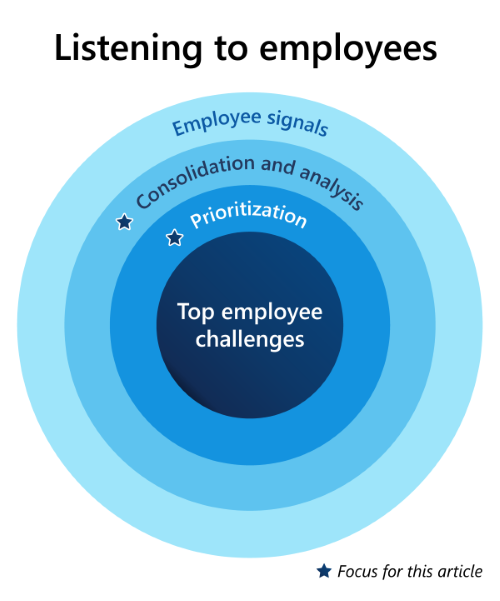 Organizations spend over $300 billion a year on employee experience. And with that level of investment, it’s critical that they deliver on the top needs of the employees, so their dollars are well spent. However, you need to make sure that you have the right investments to improve your employee experience.
Organizations spend over $300 billion a year on employee experience. And with that level of investment, it’s critical that they deliver on the top needs of the employees, so their dollars are well spent. However, you need to make sure that you have the right investments to improve your employee experience.
At Microsoft, we recognize that the best way to answer this question is to analyze the signals our employees are giving us and apply a strong prioritization model to the results. That way, we can land on an accurate list of top employee challenges.

In the first post of this series, we discussed how important it has been for us to transform Microsoft’s employee experience, and shared our strategy for capturing employee signals.
Here, we shift our focus to how we consolidate, analyze, and prioritize our employee signal data.
[Read the first blog in this series about how digital transformation is powering the Microsoft employee experience. Read the third blog in the series on how investment prioritization is driving the transformation of Microsoft’s employee experience. Learn how Microsoft Digital is reinventing Microsoft’s employee experience.]
Analysis requires subject matter expertise and context
Every source of employee signals is a data set. For us to have the best level of analysis, we have found it’s best to have experts who are close to the data and the employees providing the relevant signals in order to verify any themes identified. For example, when we get signals from a particular global role in our field (such as technical specialists), we have an expert validate the signal and give us context around what it might mean. The clarity we get comes from how well they understand any contributing factors and business context.
In the case of more technical data sets like telemetry, usage, or support incident data, we seek out application owners, support engineers, and others working in these systems to gain context. A few months ago, we noticed a 50 percent spike in employee support ticket volume related to a critical service. We verified our analysis with the support engineer who was working at the time and confirmed that an outage was the cause of the support ticket volume increase. In this case, it ended up being an acute issue as opposed to a more systemic challenge, but the conversation was critical to making this determination.
The takeaway: Every employee signal should go through verification or validation of the root cause.
Biggest challenges manifest through multiple signals
Even though they pose problems for our employees, we don’t look for the small or acute issues because they’re less important than big, complex challenges—the ones that require multiple people and organizations to work together to solve. These big problems are also often ones that haven’t been appropriately prioritized, budgeted, or solutioned. If left unattended, it’s these problems that become systemic and fundamentally harm the employee experience.
What we have learned is that those big, complex challenges are easily detected via multiple signals. We’ve also learned that it’s worth the due diligence of cross-checking any identified theme in one signal across the other signals to see if they’re related (or the same thing showing up in a different way). After cross-checking, we can have confidence that a challenge is related to a previously reported priority or that it’s a unique, new challenge.
At the conclusion of a round of analysis across all our sources of data, we have a large list of candidates that we call our “top employee challenges.” The data we use to derive these challenges becomes the reasoning behind our case for change. We’ll talk more about that in our third post in this series.
In our previous post, we spoke about our sellers having issues gaining access to a key sales system. This challenge began to reveal itself in subtle ways across almost every employee listening system we had established for sellers. We heard it in our executive reviews, in-application feedback, through support channels, in survey data, and via role-based interviews.
By triangulating across our sources, we discovered that this wasn’t just an access issue; it also illuminated a lack of consistency about how we provide access to critical tools. That lack of consistency impacted our onboarding of new employees as well as when our employees switched roles within Microsoft. The additional analysis helped us to not only better qualify the problem statement, but also gave some hypotheses for root causes. It’s because of this that we rely on multiple sources of information for a theme to emerge in our list of top employee challenges.
The takeaway: Triangulating across feedback sources leads to richer and more actionable insights.
Business impact as a prioritization model
With limited budgets and resources, our ongoing challenge is deciding which employee challenges to tackle first.
Within Microsoft, different teams have different ways of prioritizing work. We have gone through several evolutions of our prioritization model—we’ve added components, removed others, weighted them differently—but what we have found is that no prioritization model is perfect. There is a silver lining to this: every prioritization model attempts to maximize business impact, whether it’s internal or external facing. The following diagram about tackling challenges that generate business impact shows some of the employee experiences that our prioritization system could surface for us to work on next.

The point of having a model is to have a starting point for a conversation and to compare seemingly dissimilar challenges with the same set of criteria. It doesn’t have to be stack ranked if that’s too controversial, but it should be centered around your employees.
The takeaway: Use a consistent prioritization model to maximize the value of your investments.
In our final post in this three-part series—Influencing to prioritize change—we will discuss how to take an identified top employee challenge and work across your organization to influence change. We will then close the series by sharing how listening to employee signals and prioritizing them appropriately is helping us to transform Microsoft’s employee experience to make our employees even more productive and effective in their roles.

- Read the first blog in this series about how digital transformation is powering the Microsoft employee experience.
- Read the third blog in the series on how investment prioritization is driving the transformation of Microsoft’s employee experience.
- Learn how Microsoft Digital is reinventing Microsoft’s employee experience.
Tags: Analysis, change management, digital transformation, Employee Experience, feedback, Listening, Prioritization, prioritization model, Prosci, Research, Signals








